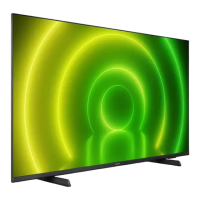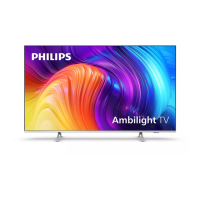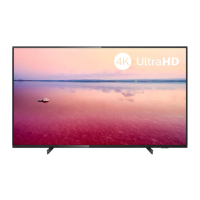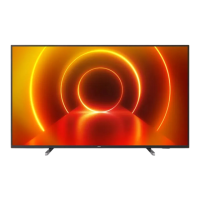Do you have a question about the Philips 50PUG7406 and is the answer not in the manual?
Explains the Home launcher, apps, and Live TV rows.
Steps to open and navigate the Home screen.
Details new features and navigation of the updated Home launcher.
Importance of reading safety instructions before use.
Instructions for installing the TV stand and wall mount.
Guidance on optimal TV placement and viewing distance.
Instructions for connecting the power cable safely.
Steps for connecting the antenna cable to the TV.
Explains the buttons on the Type 1 remote control (Top and Middle sections).
Explains the buttons on the Type 2 remote control (Bottom, Top, Middle sections).
Steps to pair the remote control with the TV using Bluetooth.
Instructions on how to use the voice search feature.
Information about the TV's infrared sensor.
Instructions for replacing remote control batteries.
How to clean the remote control.
Guide for initial channel installation during TV setup.
Steps for performing antenna channel installation.
Steps for performing cable channel installation.
Options for hiding or renaming channels.
How to watch and switch between TV channels.
Information about channel lists and searching for channels.
How to sort and filter channel lists by preference.
Copying channel lists to and from a USB flash drive.
How to tune to channels and change them.
Locking channels and setting PIN codes for content restrictions.
Setting parental ratings to restrict program viewing.
Locking input sources to prevent unauthorized access.
How to set or reset the TV's PIN code.
How to create and manage favorite channel lists for quick access.
General guide to connecting external devices to the TV.
Explanation of the HDMI ARC connection for audio return.
How to use HDMI CEC for controlling connected devices.
Setting connected HDMI devices to power off automatically.
Enabling the TV to power on from connected HDMI devices.
Checking the HDMI EDID version number.
Viewing the list of connected HDMI CEC devices.
Connecting a Home Theater System (HTS) to the TV.
Using HDMI ARC for connecting a Home Theater System.
Adjusting audio sync for Home Theater Systems.
Connecting video devices using HDMI ports.
Explanation of HDCP copy protection for HDMI ports.
Connecting audio devices via optical or headphone jacks.
Using the optical audio output for sound.
Connecting headphones to the TV's audio jack.
Requirements and installation for USB hard drives.
Minimum disk space for pausing and recording broadcasts.
Steps for installing and formatting a USB hard drive.
Warnings about USB hard drive formatting and usage.
Detailed steps for formatting a USB hard drive.
Assigning a USB device for PVR and Time shift functions.
Viewing media files (photos, music, videos) from a USB flash drive.
How to connect a computer to the TV and use it as a monitor.
Requirements for connecting wireless Bluetooth devices.
Information about potential Bluetooth audio latency issues.
Steps to pair a Bluetooth device with the TV.
How to select a paired Bluetooth device for audio output.
How to rename a paired Bluetooth device.
How to disconnect or remove a paired Bluetooth device.
Setting up network and internet connections for the TV.
Connecting the TV to a home network wirelessly or wired.
Troubleshooting common network connection issues.
Steps for establishing wireless and wired network connections.
Configuring proxy and IP settings for network connection.
Signing in to a Google Account to access services and personalization.
Instructions to sign in to your Google Account on the TV.
Overview of apps available on the TV and the Google Play Store.
Using Google Play for Movies, TV, Music, and Games.
Adding payment methods to your Google Account for purchases.
How to start, stop, and manage apps on the TV.
Managing installed apps for performance optimization.
How to select and switch between different connected input sources.
Using One Touch Play with compatible HDMI CEC devices.
Accessing core TV settings like Picture, Sound, Power, and more.
Adjusting various picture settings for optimal viewing.
Adjusting various sound settings for clear audio.
Enabling or disabling closed captions for dialogue.
Setting power saving timers and auto-off features.
Enabling or disabling the Ginga feature (Brazil only).
Accessing more detailed advanced settings.
Viewing the main settings menu structure.
Detailed picture settings like mode, display mode, and aspect ratio.
Selecting preset picture modes like Standard, Vivid, Movie.
Managing notifications for Dolby Vision content playback.
Adjusting picture aspect ratio and zoom for screen filling.
Adjusting backlight, brightness, contrast, hue, and sharpness.
Accessing advanced video processing settings.
Configuring audio modes and speaker output preferences.
Selecting sound modes like Game, Movie, Music, or Dialog.
Configuring speaker output and advanced audio processing.
Settings for optical and HDMI ARC digital audio signals.
Adjusting audio sync delay for output devices.
Enabling DTS night mode for quieter listening.
Advanced Dolby audio features like Volume Leveler and Dialogue Enhancer.
Enabling audio output through a connected USB audio device.
Setting sleep timers and auto power on/off features.
Setting the TV to turn off automatically after a preset time.
Turning off the TV screen to conserve energy.
Setting a timer for the TV to switch off automatically.
Automatically powering off the TV when no signal is detected.
Setting the TV to enter standby mode after inactivity.
Accessing advanced audio and language settings.
Setting the preferred audio language for broadcasts.
Switching sound modes for analog channels (Mono, SAP, Stereo).
Configuring and enabling the Ginga feature.
Setting timers for energy saving functions.
Enabling diagnostic data sharing with Google.
Adjusting picture settings for display quality.
Adjusting sound settings for audio output.
Activating special functions for users with disabilities.
Adjusting Ambilight lighting effects on the TV.
Checking the available device storage space.
Customizing the home screen layout and app order.
Turning retail mode on or off for store display.
Adjusting settings for Google Assistant functionality.
Adjusting settings for the Chromecast built-in feature.
Adjusting screen saver settings for display protection.
Setting the TV's location status.
Instructions on how to reboot the TV for performance.
Resetting all TV settings to their original factory defaults.
Settings for menu language, audio language, clock, and timers.
Changing the language of the TV's user interface.
Setting the preferred audio language for broadcasts.
Adjusting date, time, and time zone settings.
Setting auto power on and auto power off timers.
Features for users with visual or hearing impairments.
Enabling audio description for visually impaired users.
Options for visually impaired users, including audio adjustments.
Viewing media files from a connected USB flash drive.
How to play video files from a USB drive, including playback controls.
Displaying information about the video file.
Adjusting the display mode for video playback.
Adjusting picture settings specifically for video playback.
Adjusting sound settings specifically for video playback.
Displaying available soundtracks for a video.
Resuming video playback from the last stopped point.
How to view photos from a USB drive.
Steps to view individual photos and use photo options.
Sorting photo files by preference.
Sorting photo files by their media type.
Changing the size of photo thumbnails.
Copying files to a preferred folder.
Pasting copied files into a folder.
Deleting selected files.
Selecting a parser for photo files.
Starting the photo frame slideshow mode.
Options for viewing photos, such as pause, repeat, shuffle, duration.
How to play music files from a USB drive.
How to preview text files from a USB drive.
Information about the availability of TV Guide data.
Steps to open and use the TV Guide feature.
Options for recording, device info, schedule list, and time shift.
Viewing and managing recorded programs.
Checking the storage device information for recording.
Scheduling upcoming programs for recording.
Enabling and using the Time Shift recording mode.
What is needed to record digital TV broadcasts.
Requirements for recording TV programs, including storage.
Assigning a USB device for storing recorded content.
How to record a program instantly or schedule it.
Instructions to immediately record the current program.
Scheduling future recordings or setting reminders.
Viewing the list of all recorded programs.
How to select and play a recorded program.
How to pause and resume live TV broadcasts.
Requirements for using the Time Shift function.
Assigning a USB device for Time Shift data storage.
Steps to pause and resume a live TV broadcast.
Replaying recent segments of a live broadcast.
How to cast content from mobile devices to the TV.
Requirements for using the Google Cast feature.
Examples of popular apps that support Google Cast.
Step-by-step guide to casting content from a mobile device.
Instructions for updating the TV's software via USB or Internet.
Updating software using a computer and USB flash drive.
Updating software directly from the internet.
How to view the current TV software version and details.
Viewing the open-source licenses used by the TV software.
Information regarding product disposal and environmental impact.
Guidelines for disposing of old products and batteries correctly.
Specifications related to power consumption and saving features.
Details about the TV's operating system (Android 10).
Information about the TV's reception capabilities and tuner bands.
Specifications for screen size and resolution.
Supported input resolutions and refresh rates for video.
Detailed list of supported computer and video resolutions.
Overview of all TV ports and connectivity options.
Specifications regarding the TV's audio output power and features.
Supported multimedia file formats, codecs, and USB file systems.
Benefits and process of registering your TV.
How to access and utilize the TV's built-in help function.
Common issues and solutions for TV operation problems.
Troubleshooting TV power issues and remote control unresponsiveness.
Explanation of normal creaking sounds from the TV chassis.
Solutions for an unresponsive remote control, including battery check.
Understanding the normal startup screen behavior.
Troubleshooting the issue of a blinking standby light.
Troubleshooting problems finding digital channels during installation.
Information about setting and managing the PIN code for restrictions.
Troubleshooting common picture-related issues and distortions.
Troubleshooting common sound-related issues and quality problems.
Troubleshooting issues with HDMI and USB connections and playback.
Reasons for choppy playback of files from USB storage devices.
Troubleshooting common network connectivity problems.
Troubleshooting Bluetooth pairing and connection issues.
Steps to change the TV menu language back to the correct one.
Accessing Philips TV support resources online.
Contacting customer support and information on repairs.
Where to locate the TV's model and serial numbers.
A warning against attempting self-repair of the TV.
Important safety instructions and precautions for TV usage.
General safety precautions to read before using the TV.
Hazards related to electric shock, water, and heat exposure.
Precautions to prevent personal injury or damage to the TV.
Hazards associated with TV stability, tipping, and furniture placement.
Hazards associated with batteries, including ingestion and leakage.
Precautions to prevent the TV from overheating due to poor ventilation.
Safety measures to take during lightning storms.
Warnings about potential hearing damage from high volume usage.
Precautions for handling the TV in low temperature environments.
Information regarding condensation and humidity effects.
Instructions for cleaning and maintaining the TV screen.
Warranty conditions and risks of attempting self-repair.
Explanation of pixel variations and standards.
Information on backlight characteristics like Mura effect.
Information regarding HDMI trademarks and logos.
Information about HEVC patents and decoding.
Details on Dolby Vision and Dolby Atmos trademarks and licensing.
Details on DTS-HD trademarks and licensing.
Information regarding the DTVi brand and logo registration.
Information about the Wi-Fi CERTIFIED logo.
Information regarding Kensington trademarks.
General statement regarding other registered trademarks.
Explains the Home launcher, apps, and Live TV rows.
Steps to open and navigate the Home screen.
Details new features and navigation of the updated Home launcher.
Importance of reading safety instructions before use.
Instructions for installing the TV stand and wall mount.
Guidance on optimal TV placement and viewing distance.
Instructions for connecting the power cable safely.
Steps for connecting the antenna cable to the TV.
Explains the buttons on the Type 1 remote control (Top and Middle sections).
Explains the buttons on the Type 2 remote control (Bottom, Top, Middle sections).
Steps to pair the remote control with the TV using Bluetooth.
Instructions on how to use the voice search feature.
Information about the TV's infrared sensor.
Instructions for replacing remote control batteries.
How to clean the remote control.
Guide for initial channel installation during TV setup.
Steps for performing antenna channel installation.
Steps for performing cable channel installation.
Options for hiding or renaming channels.
How to watch and switch between TV channels.
Information about channel lists and searching for channels.
How to sort and filter channel lists by preference.
Copying channel lists to and from a USB flash drive.
How to tune to channels and change them.
Locking channels and setting PIN codes for content restrictions.
Setting parental ratings to restrict program viewing.
Locking input sources to prevent unauthorized access.
How to set or reset the TV's PIN code.
How to create and manage favorite channel lists for quick access.
General guide to connecting external devices to the TV.
Explanation of the HDMI ARC connection for audio return.
How to use HDMI CEC for controlling connected devices.
Setting connected HDMI devices to power off automatically.
Enabling the TV to power on from connected HDMI devices.
Checking the HDMI EDID version number.
Viewing the list of connected HDMI CEC devices.
Connecting a Home Theater System (HTS) to the TV.
Using HDMI ARC for connecting a Home Theater System.
Adjusting audio sync for Home Theater Systems.
Connecting video devices using HDMI ports.
Explanation of HDCP copy protection for HDMI ports.
Connecting audio devices via optical or headphone jacks.
Using the optical audio output for sound.
Connecting headphones to the TV's audio jack.
Requirements and installation for USB hard drives.
Minimum disk space for pausing and recording broadcasts.
Steps for installing and formatting a USB hard drive.
Warnings about USB hard drive formatting and usage.
Detailed steps for formatting a USB hard drive.
Assigning a USB device for PVR and Time shift functions.
Viewing media files (photos, music, videos) from a USB flash drive.
How to connect a computer to the TV and use it as a monitor.
Requirements for connecting wireless Bluetooth devices.
Information about potential Bluetooth audio latency issues.
Steps to pair a Bluetooth device with the TV.
How to select a paired Bluetooth device for audio output.
How to rename a paired Bluetooth device.
How to disconnect or remove a paired Bluetooth device.
Setting up network and internet connections for the TV.
Connecting the TV to a home network wirelessly or wired.
Troubleshooting common network connection issues.
Steps for establishing wireless and wired network connections.
Configuring proxy and IP settings for network connection.
Signing in to a Google Account to access services and personalization.
Instructions to sign in to your Google Account on the TV.
Overview of apps available on the TV and the Google Play Store.
Using Google Play for Movies, TV, Music, and Games.
Adding payment methods to your Google Account for purchases.
How to start, stop, and manage apps on the TV.
Managing installed apps for performance optimization.
How to select and switch between different connected input sources.
Using One Touch Play with compatible HDMI CEC devices.
Accessing core TV settings like Picture, Sound, Power, and more.
Adjusting various picture settings for optimal viewing.
Adjusting various sound settings for clear audio.
Enabling or disabling closed captions for dialogue.
Setting power saving timers and auto-off features.
Enabling or disabling the Ginga feature (Brazil only).
Accessing more detailed advanced settings.
Viewing the main settings menu structure.
Detailed picture settings like mode, display mode, and aspect ratio.
Selecting preset picture modes like Standard, Vivid, Movie.
Managing notifications for Dolby Vision content playback.
Adjusting picture aspect ratio and zoom for screen filling.
Adjusting backlight, brightness, contrast, hue, and sharpness.
Accessing advanced video processing settings.
Configuring audio modes and speaker output preferences.
Selecting sound modes like Game, Movie, Music, or Dialog.
Configuring speaker output and advanced audio processing.
Settings for optical and HDMI ARC digital audio signals.
Adjusting audio sync delay for output devices.
Enabling DTS night mode for quieter listening.
Advanced Dolby audio features like Volume Leveler and Dialogue Enhancer.
Enabling audio output through a connected USB audio device.
Setting sleep timers and auto power on/off features.
Setting the TV to turn off automatically after a preset time.
Turning off the TV screen to conserve energy.
Setting a timer for the TV to switch off automatically.
Automatically powering off the TV when no signal is detected.
Setting the TV to enter standby mode after inactivity.
Accessing advanced audio and language settings.
Setting the preferred audio language for broadcasts.
Switching sound modes for analog channels (Mono, SAP, Stereo).
Configuring and enabling the Ginga feature.
Setting timers for energy saving functions.
Enabling diagnostic data sharing with Google.
Adjusting picture settings for display quality.
Adjusting sound settings for audio output.
Activating special functions for users with disabilities.
Adjusting Ambilight lighting effects on the TV.
Checking the available device storage space.
Customizing the home screen layout and app order.
Turning retail mode on or off for store display.
Adjusting settings for Google Assistant functionality.
Adjusting settings for the Chromecast built-in feature.
Adjusting screen saver settings for display protection.
Setting the TV's location status.
Instructions on how to reboot the TV for performance.
Resetting all TV settings to their original factory defaults.
Settings for menu language, audio language, clock, and timers.
Changing the language of the TV's user interface.
Setting the preferred audio language for broadcasts.
Adjusting date, time, and time zone settings.
Setting auto power on and auto power off timers.
Features for users with visual or hearing impairments.
Enabling audio description for visually impaired users.
Options for visually impaired users, including audio adjustments.
Viewing media files from a connected USB flash drive.
How to play video files from a USB drive, including playback controls.
Displaying information about the video file.
Adjusting the display mode for video playback.
Adjusting picture settings specifically for video playback.
Adjusting sound settings specifically for video playback.
Displaying available soundtracks for a video.
Resuming video playback from the last stopped point.
How to view photos from a USB drive.
Steps to view individual photos and use photo options.
Sorting photo files by preference.
Sorting photo files by their media type.
Changing the size of photo thumbnails.
Copying files to a preferred folder.
Pasting copied files into a folder.
Deleting selected files.
Selecting a parser for photo files.
Starting the photo frame slideshow mode.
Options for viewing photos, such as pause, repeat, shuffle, duration.
How to play music files from a USB drive.
How to preview text files from a USB drive.
Information about the availability of TV Guide data.
Steps to open and use the TV Guide feature.
Options for recording, device info, schedule list, and time shift.
Viewing and managing recorded programs.
Checking the storage device information for recording.
Scheduling upcoming programs for recording.
Enabling and using the Time Shift recording mode.
What is needed to record digital TV broadcasts.
Requirements for recording TV programs, including storage.
Assigning a USB device for storing recorded content.
How to record a program instantly or schedule it.
Instructions to immediately record the current program.
Scheduling future recordings or setting reminders.
Viewing the list of all recorded programs.
How to select and play a recorded program.
How to pause and resume live TV broadcasts.
Requirements for using the Time Shift function.
Assigning a USB device for Time Shift data storage.
Steps to pause and resume a live TV broadcast.
Replaying recent segments of a live broadcast.
How to cast content from mobile devices to the TV.
Requirements for using the Google Cast feature.
Examples of popular apps that support Google Cast.
Step-by-step guide to casting content from a mobile device.
Instructions for updating the TV's software via USB or Internet.
Updating software using a computer and USB flash drive.
Updating software directly from the internet.
How to view the current TV software version and details.
Viewing the open-source licenses used by the TV software.
Information regarding product disposal and environmental impact.
Guidelines for disposing of old products and batteries correctly.
Specifications related to power consumption and saving features.
Details about the TV's operating system (Android 10).
Information about the TV's reception capabilities and tuner bands.
Specifications for screen size and resolution.
Supported input resolutions and refresh rates for video.
Detailed list of supported computer and video resolutions.
Overview of all TV ports and connectivity options.
Specifications regarding the TV's audio output power and features.
Supported multimedia file formats, codecs, and USB file systems.
Benefits and process of registering your TV.
How to access and utilize the TV's built-in help function.
Common issues and solutions for TV operation problems.
Troubleshooting TV power issues and remote control unresponsiveness.
Explanation of normal creaking sounds from the TV chassis.
Solutions for an unresponsive remote control, including battery check.
Understanding the normal startup screen behavior.
Troubleshooting the issue of a blinking standby light.
Troubleshooting problems finding digital channels during installation.
Information about setting and managing the PIN code for restrictions.
Troubleshooting common picture-related issues and distortions.
Troubleshooting common sound-related issues and quality problems.
Troubleshooting issues with HDMI and USB connections and playback.
Reasons for choppy playback of files from USB storage devices.
Troubleshooting common network connectivity problems.
Troubleshooting Bluetooth pairing and connection issues.
Steps to change the TV menu language back to the correct one.
Accessing Philips TV support resources online.
Contacting customer support and information on repairs.
Where to locate the TV's model and serial numbers.
A warning against attempting self-repair of the TV.
Important safety instructions and precautions for TV usage.
General safety precautions to read before using the TV.
Hazards related to electric shock, water, and heat exposure.
Precautions to prevent personal injury or damage to the TV.
Hazards associated with TV stability, tipping, and furniture placement.
Hazards associated with batteries, including ingestion and leakage.
Precautions to prevent the TV from overheating due to poor ventilation.
Safety measures to take during lightning storms.
Warnings about potential hearing damage from high volume usage.
Precautions for handling the TV in low temperature environments.
Information regarding condensation and humidity effects.
Instructions for cleaning and maintaining the TV screen.
Warranty conditions and risks of attempting self-repair.
Explanation of pixel variations and standards.
Information on backlight characteristics like Mura effect.
Information regarding HDMI trademarks and logos.
Information about HEVC patents and decoding.
Details on Dolby Vision and Dolby Atmos trademarks and licensing.
Details on DTS-HD trademarks and licensing.
Information regarding the DTVi brand and logo registration.
Information about the Wi-Fi CERTIFIED logo.
Information regarding Kensington trademarks.
General statement regarding other registered trademarks.
| Screen Size | 50 inches |
|---|---|
| Resolution | 4K UHD (3840 x 2160) |
| Display Technology | LED |
| Smart TV | Yes |
| Operating System | Android TV |
| HDMI Ports | 3 |
| USB Ports | 2 |
| Audio Output | 20W |
| Ambilight | Yes |
| Refresh Rate | 60Hz |
| Wi-Fi | Yes |
| Bluetooth | Yes |
| HDR | HLG |











